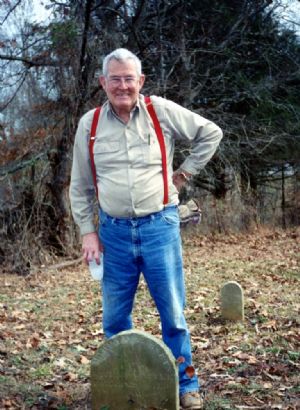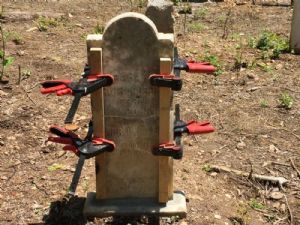Feb 2019 StoryGone But Not Forgotten Written By Angela Stout February 2019 Cemeteries are a wealth of genealogy information! People were often buried in family cemeteries on their land and often buried physically near each other. Sometimes they were buried with the husband’s family but sometimes not. Tombstones can range from an unmarked slate rock to an engraved rock with life milestones. While doing research, I find that sometimes the birth or death dates do not match birth or death certificates. Before birth and death certificates, it is often the family Bible that has those dates. Military service/pension records are good sources for birth and death dates. It has been a tradition in many cemeteries to meet once a year to fellowship, conduct cemetery business and decorate family tombstones…it is called a Decoration. The literal definition of Decoration Day or "Decoration" taken from the Dictionary of Smoky Mountain English is: "An occasion on which a family or a church congregation gathers … to place flowers on the graves of loved ones and to hold a memorial service for them. Traditionally this involved singing, dinner on the ground as well as a religious service." Decorations of the past were a big deal with family coming in from all over in their Sunday best to spend time together remembering their loved ones who had passed. I am told that people would clean off the cemeteries, spread blankets all over the cemetery to sit and eat a picnic meal together. In the early 1900 Putnam County newspaper, they often comment about Decorations. For example, on 11 May 1911, James Stewart wrote to the newspaper about the upcoming Boma Decoration. I am told that the Smellage Cemetery first Decoration was in 1900. At that decoration they chose the fourth Sunday in May as the date of its annual Decoration Day and it continues to this day. At first people brought whatever flowers were in bloom in their yards. Then they began to make paper flowers out of paper torn from their children’s notebooks. Petals were cut out and rolled around the long hat pins that women used to wear stuck through their hats. After the petals curled, they were stuck on pieces of broom straw. After colored paper became available, this was used and the finished flowers were dipped in paraffin. Still later, colored crepe paper was used to make flowers. Today, plastic flowers, professional florists ’wreaths, and home grown flowers are all used. I would love to learn how to make these paper flowers of the past. The history of the Smellage Cemetery Decoration tells that hundreds of people used to come for Decoration from far and near – on foot, by horseback, or with whole families in wagons. The Tennessee Central Railway used to put on an extra coach to deliver the large crowds of people. Housewives used to cook for days. After a morning song service and sermon, the service would break for “dinner on the ground.” Here is a photo taken of some of our ancestors while at the Smellage Decoration (May 1948 or 1949).
Daily Roberts, Pearl holding Edward Eugene, Betty, Dean, Andrew, Maude, Roshie, Boda, Bessie, Owen, Ruth, Ruby and Royce Cemeteries are a great place to learn about our ancestors. Here are four Joseph Roberts’ descendants at his tombstone. Let’s pass down our heritage to the younger generations! Sadly, Decoration Day is not as well attended as the past. Adding to this decline is the fact that some family cemeteries are getting grown over. Tombstones are broken or lost. We still have ancestors who don’t have tombstones. When this happens we have to ask ourselves are we truly honoring our ancestors. Maybe we can do something to turn this trend around. Cemeteries are hard work to maintain and the work is often not appreciated. Mowing, weed eating, spraying roundup, filling in sunken graves, fixing broken tombstones, putting in fence and gates all takes work. If this is something that is tugging at your heart as you read this, please consider jumping in to help maintain your ancestors’ cemetery! You can contact me and I can get you pointed to the right direction. Here are some pictures that I have found in our archives of cemetery cleaning from when my grandfather was alive to today, where others continue to honor the fallen by maintaining and restoring graveyards. Cleaning the Joseph Roberts Cemetery Avery Roberts working hard on the Apple Cemetery over growth. Sisters, Geraldine (Roberts) Herren and Brenda (Roberts) Logsdon, cleaning the fence row at a cemetery working. Lamar Dew smiling and working to clean up a cemetery. Richardson Cemetery where the two Civil War Richardsons are buried. Restoring Sarah Richardson’s broken tombstone in the Richardson Cemetery. Special day - Jim and Joyce Joseph placing a marker for William Alexander Cronk and his wife Malissa (Roberts) Cronk years after they died…to remember. Maybe you are like me, where you might not even know where your ancestors are buried. If so, maybe we can help each other! My father, Tommy Roberts, left Roberts Switch in 1965 to join the Air Force. On a visit home, his father, Clavis Roberts, asked him to take him to the graves of each of his great aunts and uncles. My father and grandfather sought out the location of each gravesite when my dad would come home for a visit. This also contributed to my father’s love of genealogy and the desire to ensure that we honor our ancestors by maintaining their cemeteries. I just recently jumped in the car my dad to visit those same gravesites that he and my grandfather sought out years ago. Here is a synopsis of the Joseph Roberts children cemeteries and what I currently know.
|








